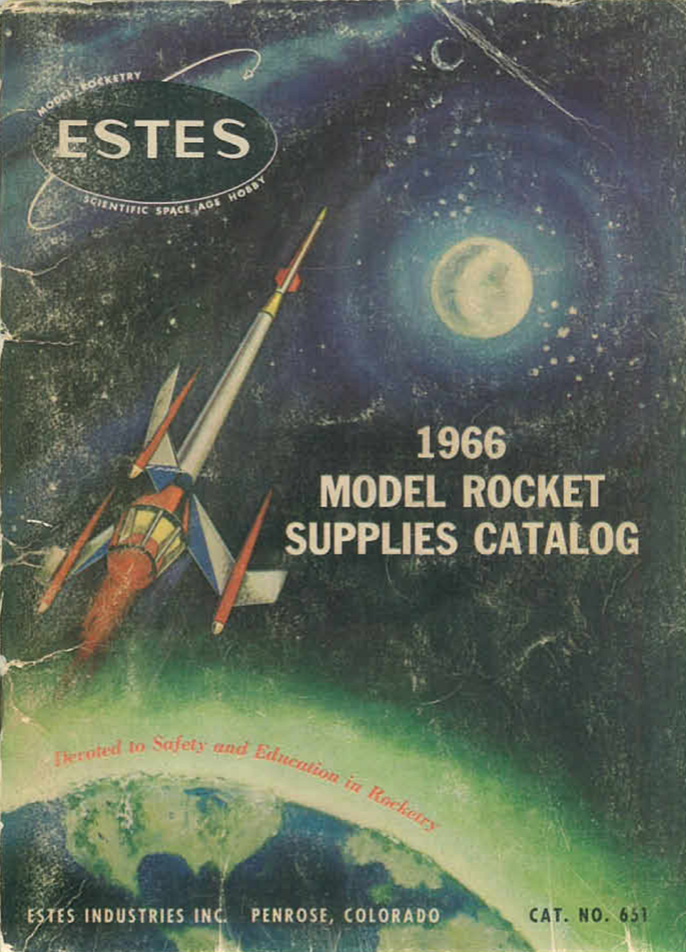


1966
Rocket Man
Queue song: Rocket Man by Elton John
'Til touchdown brings me 'round again to find
I'm not the man they think I am at home
Oh, no, no, no
I'm a rocket man
And all this science
I don't understand
A rocket man
A rocket man
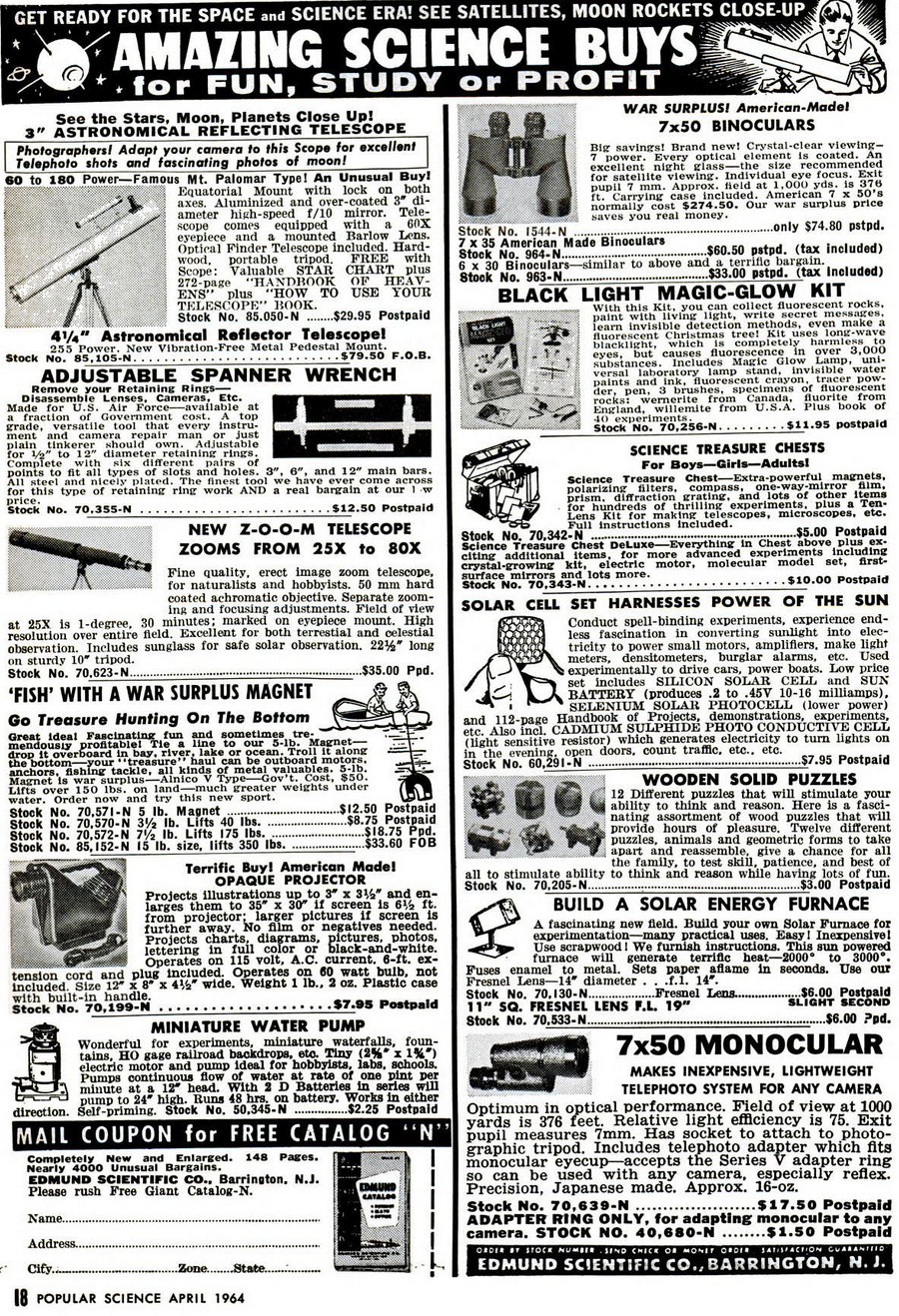 I would read Popular Science cover to cover, even the
advertisements. In every issue there was a full page ad for Edmund
Scientific, “Amazing Science Buys, for Fun, Study or Profit” it said
in bold letters across the top and then showing all sorts of
interesting science things, telescopes, magnets, solar cells and so
on, each month’s add showing different items. I filled out the
catalog order coupon at the bottom of the ad and sent it in with it
arriving in the mail a couple of weeks later. It was so cool,
filled with all sorts of scientific things, carefully went though
each page using with my imagination thinking of what I could make
with one item or another. I would save up my allowance and lawn
mowing money and every few months put in an
order for five or six dollars getting such things as a gyroscope,
magnets and other small items. It was one of my favorite catalogs
for many years.
I would read Popular Science cover to cover, even the
advertisements. In every issue there was a full page ad for Edmund
Scientific, “Amazing Science Buys, for Fun, Study or Profit” it said
in bold letters across the top and then showing all sorts of
interesting science things, telescopes, magnets, solar cells and so
on, each month’s add showing different items. I filled out the
catalog order coupon at the bottom of the ad and sent it in with it
arriving in the mail a couple of weeks later. It was so cool,
filled with all sorts of scientific things, carefully went though
each page using with my imagination thinking of what I could make
with one item or another. I would save up my allowance and lawn
mowing money and every few months put in an
order for five or six dollars getting such things as a gyroscope,
magnets and other small items. It was one of my favorite catalogs
for many years.
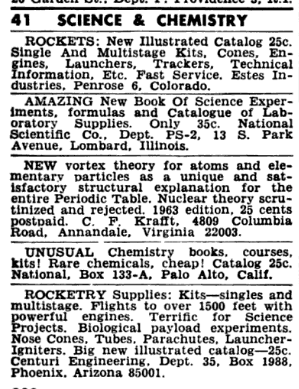 But
it was in the back of the magazine I discovered rockets. In the back
of each issue were small, classified ads arranged in categories.
Some categories were a specific, like number 18, “Earthworms,
Crickets, Frogs” but the one that interested me the most was
category #41, “Science & Chemistry” which I discovered a small ad by
a company called Estes Industries, “ROCKETS: New Illustrated Catalog
25¢”, it said, providing an address. I was interested so I taped a
quarter to a card with my address, put it into an envelope and sent
it to them. A couple of weeks later I received their catalog. I was
surprised, Estes sold real rockets, not very big ones granted, but
they were real. They came as kits which after assembling you
inserted a rocket engine into which would propel it into the sky.
Although the engines were used only once, the rockets were reusable,
just put another engine in and launch again. I ordered the smallest,
simplest one in the catalog, the Astron Scout, at 70¢ plus three
engines for 65¢, the Electro-Launcher kit at $3.50, and 95¢ for
shipping for a total of $5.80. I checked the mailbox every day the
following week until the package arrived. It was a simple kit, a
cardboard tube about four inches
But
it was in the back of the magazine I discovered rockets. In the back
of each issue were small, classified ads arranged in categories.
Some categories were a specific, like number 18, “Earthworms,
Crickets, Frogs” but the one that interested me the most was
category #41, “Science & Chemistry” which I discovered a small ad by
a company called Estes Industries, “ROCKETS: New Illustrated Catalog
25¢”, it said, providing an address. I was interested so I taped a
quarter to a card with my address, put it into an envelope and sent
it to them. A couple of weeks later I received their catalog. I was
surprised, Estes sold real rockets, not very big ones granted, but
they were real. They came as kits which after assembling you
inserted a rocket engine into which would propel it into the sky.
Although the engines were used only once, the rockets were reusable,
just put another engine in and launch again. I ordered the smallest,
simplest one in the catalog, the Astron Scout, at 70¢ plus three
engines for 65¢, the Electro-Launcher kit at $3.50, and 95¢ for
shipping for a total of $5.80. I checked the mailbox every day the
following week until the package arrived. It was a simple kit, a
cardboard tube about four inches 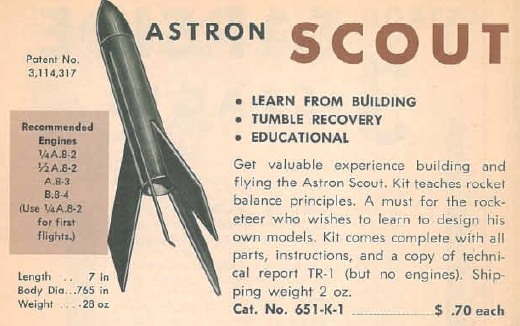 long, a piece of balsa wood which
you cut three fins out of using a template they provided, a balsa
wood nose cone, and a short piece of soda straw for the launching
rod guide. I cut out the fins, gluing them and the nose cone to the
cardboard tube with Elmer’s glue and then painted it using a small
jar of yellow Testor’s paint that I got from Toy Land.
long, a piece of balsa wood which
you cut three fins out of using a template they provided, a balsa
wood nose cone, and a short piece of soda straw for the launching
rod guide. I cut out the fins, gluing them and the nose cone to the
cardboard tube with Elmer’s glue and then painted it using a small
jar of yellow Testor’s paint that I got from Toy Land.
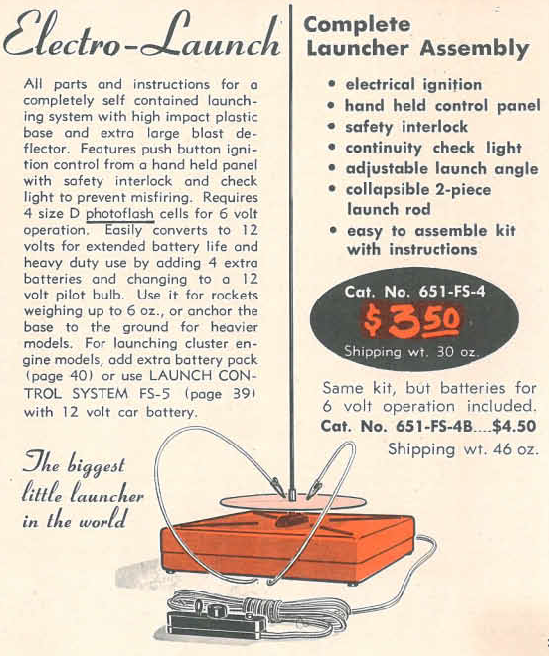 With
the rocket built and painted I was ready to launch. I set the launch
pad up in the driveway, sliding the rocket onto the guide rod. The
launch pad was a simple plastic box with a metal plate on top and a
30 inch metal guide rod pointing towards the sky. I put batteries
in the controller and attached the wires to the engine igniter
wires. The engines are simple solid fuel things with a nozzle at
one end in which you inserted an igniter wire which, got hot when
electricity flowed though it, igniting the engine. I was all set,
the wire to the controller was about ten feet long which seem a bit
close, but I was ready. I gave the count down, five, four, three,
two, one, and pressed the button and nothing happened. Ok what do I
do now? Was this like some dud firecracker that may still be
burning and go off at any time? I recheck everything, checking the
connections, pushed the button again and in whoosh the rocket went
shooting into the sky. I hardly knew where it went it took off so
fast and I was looking at the launch pad not up in the sky. I
quickly looked up and there it was, falling back down to land in the
neighbor’s yard across the street. Wow! That was cool. After
recovering the rocket, taking the spent engine out and putting a
fresh one end launching it twice more.
With
the rocket built and painted I was ready to launch. I set the launch
pad up in the driveway, sliding the rocket onto the guide rod. The
launch pad was a simple plastic box with a metal plate on top and a
30 inch metal guide rod pointing towards the sky. I put batteries
in the controller and attached the wires to the engine igniter
wires. The engines are simple solid fuel things with a nozzle at
one end in which you inserted an igniter wire which, got hot when
electricity flowed though it, igniting the engine. I was all set,
the wire to the controller was about ten feet long which seem a bit
close, but I was ready. I gave the count down, five, four, three,
two, one, and pressed the button and nothing happened. Ok what do I
do now? Was this like some dud firecracker that may still be
burning and go off at any time? I recheck everything, checking the
connections, pushed the button again and in whoosh the rocket went
shooting into the sky. I hardly knew where it went it took off so
fast and I was looking at the launch pad not up in the sky. I
quickly looked up and there it was, falling back down to land in the
neighbor’s yard across the street. Wow! That was cool. After
recovering the rocket, taking the spent engine out and putting a
fresh one end launching it twice more.
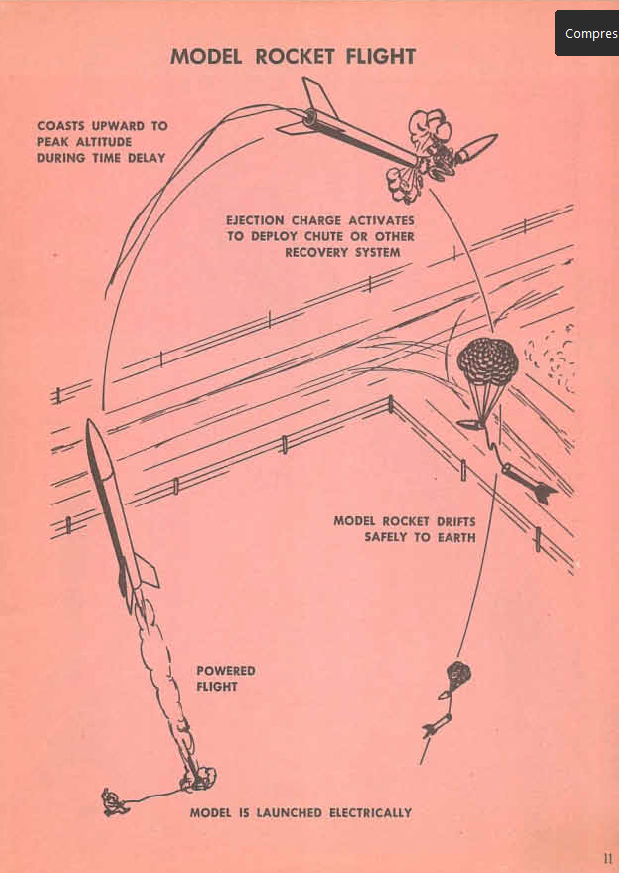 That
was fun, I was ready for the for the next step up and ordered the Astron
Alpha rocket ($1.50) which was twice the size and landed using a
parachute. While the Scout used the smallest of engines, the Astron
Mark used a more powerful engine which at the top of its flight
would expel a gas that would push the parachute out. I cut the fins
and glued them on the body then painted the rocket. The
parachute, about a foot in diameter, was then carefully rolled up
and inserted into the top of the rocket tube followed by the nose
cone on top. Launch day came and again I set up in the driveway.
After the countdown I pressed the button and whoosh off it went into
the sky then at its peak, a pop and the parachute came out and the
rocket gently floated down to land in the neighbor’s yard two houses
down. The second launch went as well but by the time of the third
launch a slight breeze had picked up and the rocket landed on a
neighbor’s roof. I knew the neighbors so went around to the back of
their house, climbed up the kerosene tank that all the houses in the
neighborhood had for their heaters, and then onto the roof to
retrieve the rocket.
That
was fun, I was ready for the for the next step up and ordered the Astron
Alpha rocket ($1.50) which was twice the size and landed using a
parachute. While the Scout used the smallest of engines, the Astron
Mark used a more powerful engine which at the top of its flight
would expel a gas that would push the parachute out. I cut the fins
and glued them on the body then painted the rocket. The
parachute, about a foot in diameter, was then carefully rolled up
and inserted into the top of the rocket tube followed by the nose
cone on top. Launch day came and again I set up in the driveway.
After the countdown I pressed the button and whoosh off it went into
the sky then at its peak, a pop and the parachute came out and the
rocket gently floated down to land in the neighbor’s yard two houses
down. The second launch went as well but by the time of the third
launch a slight breeze had picked up and the rocket landed on a
neighbor’s roof. I knew the neighbors so went around to the back of
their house, climbed up the kerosene tank that all the houses in the
neighborhood had for their heaters, and then onto the roof to
retrieve the rocket.
I looked in the catalog for the next rocket to build, there was a
whole line of the Astron series, the Sky Hook, the Cobra with three
engines, the Ranger also with three engines but big enough to carry
and egg, the Farside with three stages and many more. There were also the models of the U.S. space program,
Gemini-Titan, a three foot high Saturn 1-B
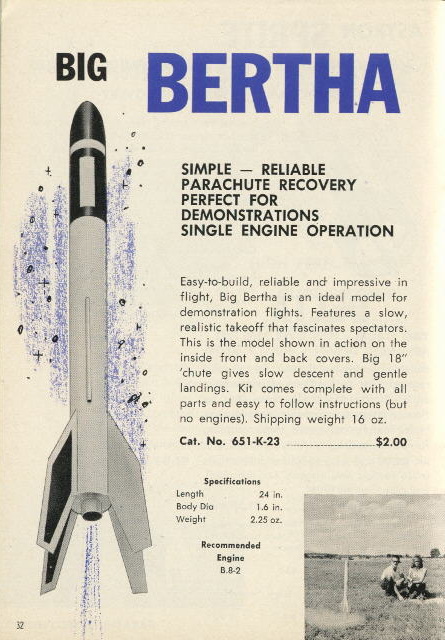 and even a model of the
German V-2 rocket.
The V2 rocket was used in World War II by Germany for attacks on England. The V2 was designed by Wernher von
Braun who after the war came to the U.S. and became the head of the U.S. space program.
and even a model of the
German V-2 rocket.
The V2 rocket was used in World War II by Germany for attacks on England. The V2 was designed by Wernher von
Braun who after the war came to the U.S. and became the head of the U.S. space program.
![]() There were rocket gliders
that went up like a rocket but came down as a glider. I didn’t
think I was ready for multiple engines or stages yet, so I got Big
Bertha [photo], two feet tall, single stage, big payload. I flew
Big Bertha quite a few times, it didn’t go all that high but being
so big was easier to see than the faster smaller models. It was Big
Bertha that took Freddy, the frog astronaut into low earth orbit.
Just kidding, he didn’t make orbit but did fly in Big Bertha and
safely returned to Earth.
The V2 rocket was used in World War II
by Germany for attacks on England. The V2 was designed by Wernher
von Braun who after the war came to the U.S. and became the head of
the U.S. space program.
There were rocket gliders
that went up like a rocket but came down as a glider. I didn’t
think I was ready for multiple engines or stages yet, so I got Big
Bertha [photo], two feet tall, single stage, big payload. I flew
Big Bertha quite a few times, it didn’t go all that high but being
so big was easier to see than the faster smaller models. It was Big
Bertha that took Freddy, the frog astronaut into low earth orbit.
Just kidding, he didn’t make orbit but did fly in Big Bertha and
safely returned to Earth.
The V2 rocket was used in World War II
by Germany for attacks on England. The V2 was designed by Wernher
von Braun who after the war came to the U.S. and became the head of
the U.S. space program.
t wasn’t long before I got several other of my friends interested in
Estes rockets and we would occasionally get together to launch
them. I had learned that our driveway was not the best place to
launch the rockets, particularly for the ones that went higher so we
moved our launches to the open field behind the houses across the
street (see neighborhood) which proved to be a good idea after the
parachute of one rocket didn’t deploy coming straight down like an
arrow sticking several inches into the ground. Later that summer I
planned a rocket launch meet that all the guys would bring a rocket
and we would all launch them on the same day. I started several
weeks ahead building a launch
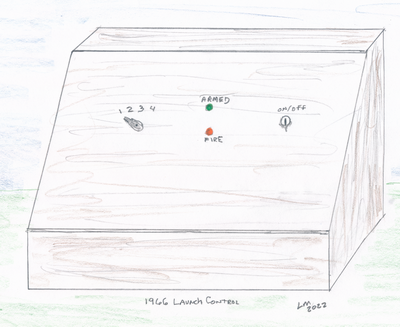 control
panel, a wooden box made out of plywood the size of a small
suitcase, okay, it was a little large, but, hey, it was cool. It
had an enable switch that required a key to turn on, a light to show
that it was active, a four position switch to select the rocket on
the pad and then a launch button. I placed a big 6 volt lantern
battery inside and ran a multiple wire cable out to the launch pad.
I constructed the lunch pad by putting a couple of logs into the
ground for posts and then running a 2x6 board across the top with
four holes drilled about a foot apart for the launching rods to be
put into. We were ready to go.
control
panel, a wooden box made out of plywood the size of a small
suitcase, okay, it was a little large, but, hey, it was cool. It
had an enable switch that required a key to turn on, a light to show
that it was active, a four position switch to select the rocket on
the pad and then a launch button. I placed a big 6 volt lantern
battery inside and ran a multiple wire cable out to the launch pad.
I constructed the lunch pad by putting a couple of logs into the
ground for posts and then running a 2x6 board across the top with
four holes drilled about a foot apart for the launching rods to be
put into. We were ready to go.
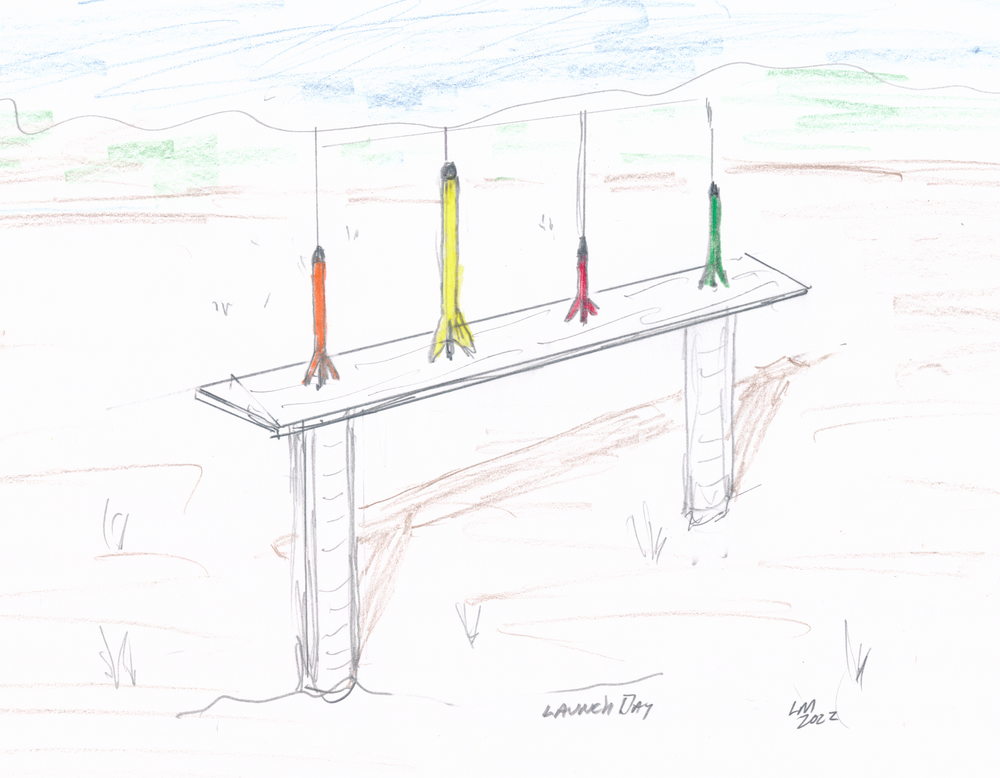
Launch day came and brought Big Bertha and another smaller rocket and the guys brought several more and we head out to the field. The guys made positive comments about my launch control panel and launch pad as each of them proceeded to prep their rockets for launch, sliding them down over the guide rod and connecting the launch wires to the engine igniter then all stepping back behind me at the control panel. The colorfully painted rockets looked sharp sitting on the launch pad, all the guys anxiously waiting the first launch. I pull the key out of my pocket, insert it into the switch, then turned the key. The green Armed light came on, I set the switch to launch pad one which was my rocket and started the count down. Five, four, three, two, fire and I pressed the fire button, the engine igniter makes a fizzle and the rockets the blasts off into the air. I used the biggest engine for the model so it went really high and I lost sight of it when some one yelled “I see it.” And pointed up, the bright orange parachute opened up and it was floating down. Everyone takes off running to get to where it was going to land, arriving just after it touched down. I gather up the rocket and we head back for the next launch and so on until all four rockets had been launched. It was a successful day, all were happy.
I built several more sophisticated Estes rockets, one that had a folded wing that would open up and then glide down, a futuristic U.S. Space Force rocket, and years later one that look like the space shuttle. The one I thought was the coolest though was the Astron Camroc, a two stage rocket with a camera on top which would take aerial photos. The camera was $4.00 and the rocket to launch it was another $5.00, expensive for me but I used my hard earned money and ordered it. It arrived and I assembled it then took it out to the field and launched it. It flew well and floated back down on it’s parachute which I gathered up and took home. The biggest problem with the Camroc was the development of the film which was in a small plastic container containing a single piece of film that slipped into the camera. It’s not something I could just take down the local Eckerd’s pharmacy to get developed like we did with camera film. The cartage had to be sent back to Estes to be developed for $.75 plus postage. I sent my single photo off and a couple of weeks later it arrived back and turned out quite well, you could see the field and even the 7-11 across the street. Alas, due to the effort and costs, my Camroc never flew again.
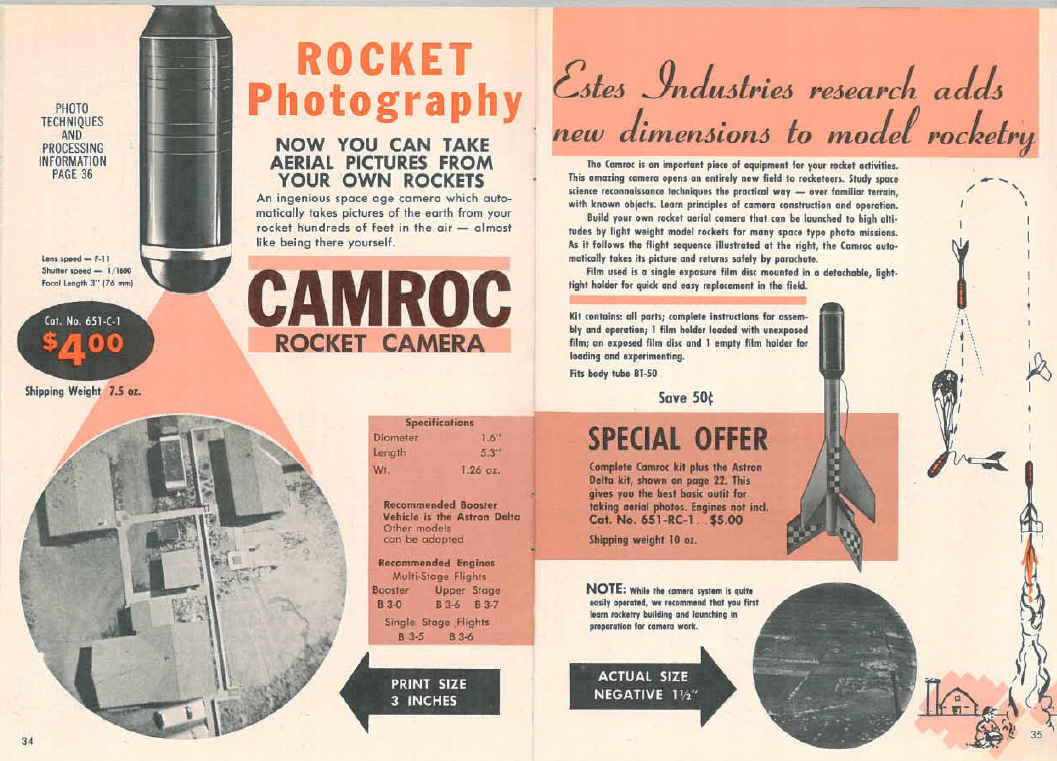
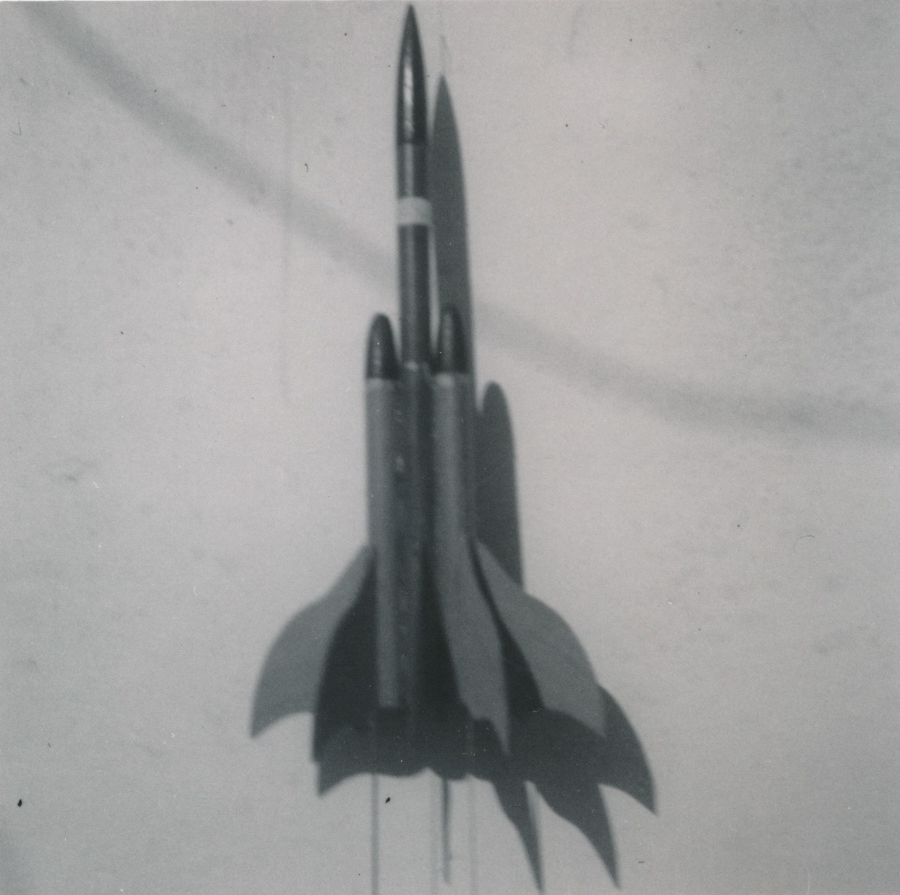
I advanced to designing and building my own rockets, the one at the
right having three engine tubes with nose cones and eight fins.
Years later NASA used my design for the space shuttle with two solid
boosters on ether side of the shuttle although fewer fins then my
design
Updated: 09-13-2022
